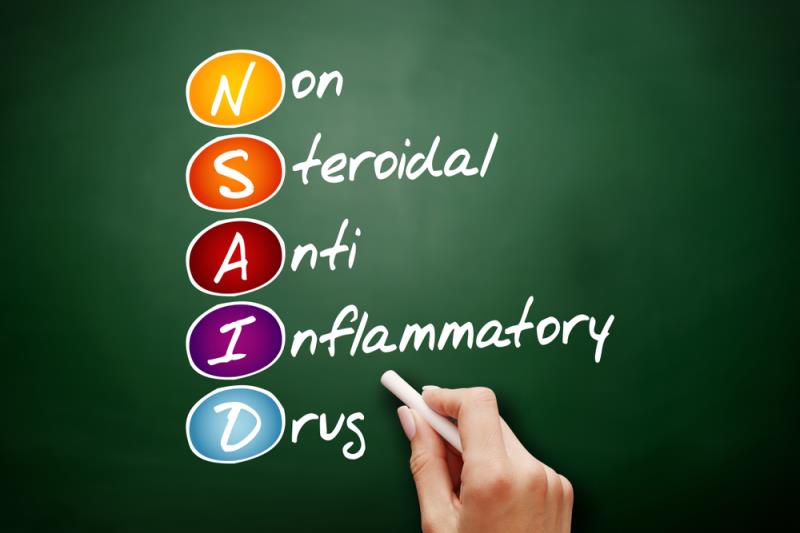
The use of NSAIDs, but not aspirin, is associated with a significantly reduced risk of colorectal cancer (CRC) at 6–36 months after a negative index colonoscopy, with chemopreventive effects observed in both proximal and distal cancers, a large retrospective cohort study in Hong Kong has shown.
Among 187,897 patients aged ≥40 years who underwent colonoscopy at public hospitals in Hong Kong between 2005 and 2013, 854 cases (0.45 percent) of post-colonoscopy CRC were diagnosed at 6–36 months after a negative index procedure (PCCRC-3y), with an overall incidence of 15.2 per 10,000 person-years. The PCCRC-3y cases included 707 cases (82.8 percent) of distal cancer and 147 cases (17.2 percent) of proximal cancer. The patients’ median age at PCCRC-3y diagnosis was 75.9 years, with a median interval of 1.2 years between index colonoscopy and PCCRC-3y diagnosis. [Aliment Pharmacol Ther 2020, doi: 10.1111/apt.15693]
The use of NSAIDs for ≥90 days before index colonoscopy was associated with a 46 percent lower risk of PCCRC-3y (adjusted hazard ratio [aHR], 0.54; 95 percent confidence interval [CI], 0.41 to 0.70), with a chemopreventive effect seen in both proximal cancer (aHR, 0.48; 95 percent CI, 0.24 to 0.95) and distal cancer (aHR, 0.55; 95 percent CI, 0.40 to 0.74).
Among 21,757 individuals who used NSAIDs (median duration of use, 0.7 years) within 5 years before the index colonoscopy, 55 (0.25 percent) were diagnosed with PCCRC-3y, with an incidence of 8.4 per 10,000 person-years. The incidence of PCCRC-3y among non-users of NSAIDs was 16.1 per 10,000 person-years.
In 18,212 study participants who used only one NSAID, a significant reduction in risk of PCCRC-3y was seen with diclofenac (aHR, 0.48; 95 percent CI, 0.33 to 0.73) and naproxen (aHR, 0.38; 95 percent CI, 0.16 to 0.92), but not with other NSAIDs.
Compared with those who never used NSAIDs, a longer duration (>1 year) of NSAID use was associated with a larger reduction in PCCRC-3y risk (aHR, 0.42; 95 percent CI, 0.26 to 0.65) than a shorter duration (≤1 year) of use (aHR, 0.53; 95 percent CI, 0.45 to 0.62; ptrend<0.001). More frequent (≥weekly) NSAID use conferred a larger protective effect (aHR, 0.46; 95 percent CI, 0.32 to 0.67) than infrequent (<weekly) use (aHR, 0.53; 95 percent CI, 0.45 to 0.61; ptrend<0.001). Similar results were seen for both proximal and distal cancers.
In a subgroup analysis, the protective effect of NSAIDs on PCCRC-3y was found to be limited to patients aged ≥60 years (aHR, 0.48; 95 percent CI, 0.35 to 0.66), those without diabetes mellitus (aHR, 0.55; 95 percent CI, 0.41 to 0.73), and those with no history of colonic polyps and/or polypectomy (aHR, 0.46; 95 percent CI, 0.32 to 0.67). Females had a larger reduction in PCCRC-3y risk from NSAID use (aHR, 0.43, 95 percent CI, 0.28 to 0.66) than males (aHR, 0.63; 95 percent CI, 0.44 to 0.91).
However, aspirin use was not associated with a reduced risk of PCCRC-3y (aHR, 1.01; 95 percent CI, 0.80 to 1.28; p=0.92).
“Although the magnitude of protection of NSAIDs against PCCRC-3y in our study was similar to that reported in studies on NSAIDs against all CRCs, our results would shed new light onto the potential chemopreventive effects of NSAIDs on CRC development according to the timing of NSAID use and colonoscopy,” the investigators suggested.
“However, our results on individual NSAID analysis should be interpreted with caution due to the small number of events in patients using NSAIDs other than diclofenac and naproxen,” they added.